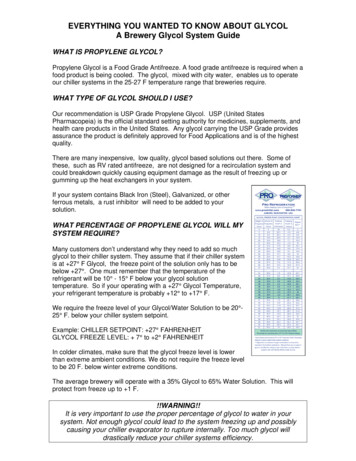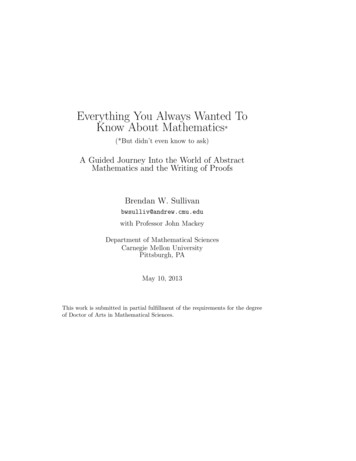
Transcription
EVERYTHING YOU WANTED TO KNOW ABOUT GLYCOLA Brewery Glycol System GuideWHAT IS PROPYLENE GLYCOL?Propylene Glycol is a Food Grade Antifreeze. A food grade antifreeze is required when afood product is being cooled. The glycol, mixed with city water, enables us to operateour chiller systems in the 25-27 F temperature range that breweries require.WHAT TYPE OF GLYCOL SHOULD I USE?Our recommendation is USP Grade Propylene Glycol. USP (United StatesPharmacopeia) is the official standard setting authority for medicines, supplements, andhealth care products in the United States. Any glycol carrying the USP Grade providesassurance the product is definitely approved for Food Applications and is of the highestquality.There are many inexpensive, low quality, glycol based solutions out there. Some ofthese, such as RV rated antifreeze, are not designed for a recirculation system andcould breakdown quickly causing equipment damage as the result of freezing up orgumming up the heat exchangers in your system.If your system contains Black Iron (Steel), Galvanized, or otherferrous metals, a rust inhibitor will need to be added to yoursolution.WHAT PERCENTAGE OF PROPYLENE GLYCOL WILL MYSYSTEM REQUIRE?Many customers don’t understand why they need to add so muchglycol to their chiller system. They assume that if their chiller systemis at 27 F Glycol, the freeze point of the solution only has to bebelow 27 . One must remember that the temperature of therefrigerant will be 10 - 15 F below your glycol solutiontemperature. So if your operating with a 27 Glycol Temperature,your refrigerant temperature is probably 12 to 17 F.We require the freeze level of your Glycol/Water Solution to be 20 25 F. below your chiller system setpoint.Example: CHILLER SETPOINT: 27 FAHRENHEITGLYCOL FREEZE LEVEL: 7 to 2 FAHRENHEITIn colder climates, make sure that the glycol freeze level is lowerthan extreme ambient conditions. We do not require the freeze levelto be 20 F. below winter extreme conditions.The average brewery will operate with a 35% Glycol to 65% Water Solution. This willprotect from freeze up to 1 F.!!WARNING!!It is very important to use the proper percentage of glycol to water in yoursystem. Not enough glycol could lead to the system freezing up and possiblycausing your chiller evaporator to rupture internally. Too much glycol willdrastically reduce your chiller systems efficiency.
I HAVE DETERMINED MY PERCENTAGE, HOW MUCH GLYCOL WILL INEED FOR MY SYSTEM?You will need to calculate your total system volume. Add the estimated volume of yourtotal system piping, plus your tank jackets, and the reservoir size on your chillersystem. Your plumbing contractor and tank manufacturer can help with piping andjacket volume estimates- the chiller system tank capacity should be available from theequipment manufacturer.HOW DO I FIND OUT THE SOLUTION PERCENTAGE (GLYCOL FREEZEPOINT) OF AN EXISTING SYSTEM?The easiest way is to use a Refractometer, in fact many breweries and wineries haveinstruments that will provide a reading in degree brix. Although propylene glycol doesn’tcontain sugars, it affects the refractive index in a similar fashion.Most chiller system manufacturers would also be happy to test the freezepoint/concentration of solution samples that are sent to them.Weight %PropyleneGlycolVolume %PropyleneGlycolFreezingPoint inFahrenheitFreezingPoint haded area represents recommended Glycol Water Percentage*Glycol freeze point should be 20 to 25 F. below operating temperature or belowcoldest winter ambient conditions. Whichever is coldest.** Degree Brix is a measure of sugar concentration in a fluid and is importantin fermentation applications. Although there are no sugars in glycol, it willaffect the refractive index of the fluid in a similar fashion.
WHERE DO I PURCHASE GLYCOL FROM?Suppliers:A) Houghton Chemical CorporationPhone: (617) 254-1010Notes: Houghton Chemical has a nationwide distribution network. Houghton alsomanufactures a product with rust inhibitors.B) DOW Chemical CorporationPhone: (800) 447-4369Notes: Dow also manufactures a product with rust inhibitors.C) Most Major Chemical SuppliersNotes: It is likely that your current chemical supplier offers USP Grade Propylene GlycolWHAT TYPE OF PIPING MATERIAL SHOULD BE USED FOR MY GLYCOLPIPING.We feel there are two feasible choices for Glycol Piping Loops; COPPER or Schedule80 PVC. Do not overlook the importance of pipe insulation also, not only to gain systemefficiencies, but also to prevent condensation.Glycol Piping Choices:COPPERCopper Pipe should be your first option for yourglycol loop. Although materials and installation willbe higher than PVC Pipe, when correctly installedyou will receive years of trouble free service.Consult with your plumbing contractor to insure yourpiping is correctly sized, undersized piping willcause increased Glycol Line pressures, possiblyjeopardizing your tank cooling jackets.Sc. 80 PVCIf budget constraints do not allow for copper, Yournext option is Sc. 80 PVC (do not use Sc 40 PVC).The colder PVC pipe gets the more brittle it gets,most problems are due to insufficient support of thePVC pipe.It is highly recommended that a Y-Strainer beinstalled on your glycol system, especially if PVC Pipe is used. PVC shavings arefamous for causing glycol solenoid valves to hang open, “over-chilling” the beer.
HOW SHOULD MY GLYCOL LINES BE INSTALLED?Several factors should be considered when designing and laying out your glycol piping.1. Set your chiller system as close to vessels as possible. You want the leastamount of restriction as possible between the chiller system and vessels.2. Be careful not to use too many pipe fittings or undersize the piping. Undersizedpiping and fittings will cause increased Glycol Line pressures, possiblyjeopardizing your tank cooling jackets.3. Use the “FIRST IN / LAST OUT” Piping method for your Fermenters. The FIRSTTank to be supplied with Glycol from your SUPPLY Header, should be the LASTTank connected to your RETURN Header. Please see illustration below. Thishelps balance the system flow, ensuring equal flow distribution to each vesselconnected to your system.4. Install pressure (0-50 lb.) and temperature (0-50F.) gauges in the SUPPLYheader. Place them in a high visibility location. These gauges can alert you to acooling system problem and / or a pressure problem.5. Although most brewery designed chiller systems are supplied with an internalPressure Bypass Valve on the Supply Line, installing an additional one at the endof your SUPPLY header is recommended. These adjustable valves will bypassflow from your supply header to your return header, protecting your tank coolingjackets from over pressurization.6. Each Fermenter should have a dedicated chilled water solenoid valve controlledby a temperature control that senses the product temperature. When yourproduct temperature drops to the set point temperature the solenoid valve willclose shutting off the flow of glycol. It is a good idea to install a manual bypassaround each solenoid valve. This manual bypass will allow the ability to cooleach vessel in the event of a temperature control failure or solenoid coil burn out.
The average brewery will operate with a 35% Glycol to 65% Water Solution. This will protect from freeze up to 1 F. !!WARNING!! It is very important to use the proper percentage of glycol to water in your system. Not enough glycol could lead to the system freezing up and possibly causing your chiller evaporator to rupture internally.











